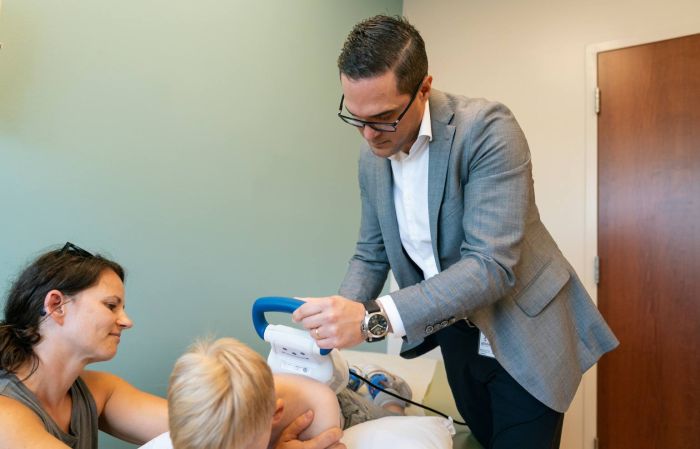For parents hearing their child has a diagnosis of scoliosis, the first question is usually: what comes next?
The answer depends on many factors. First, it’s important to define exactly what scoliosis is and how it can affect a person.
What is scoliosis?
Scoliosis is the curvature of the spine that is most often diagnosed in adolescents. The providers at Gillette Children’s will diagnose scoliosis by performing a physical exam and taking an x-ray of the spine.
Through the x-ray, healthcare providers can see if a child’s spine looks like an “S” or a “C”, instead of a straight line. Medical experts say a slight curve in the spine may be common, but a spinal curve of 10 degrees or greater is a characteristic of scoliosis.
There are 3 main types of scoliosis:
- Idiopathic Scoliosis: a type of in which the spine is curved, but the cause is unknown
- Neuromuscular Scoliosis: this type of scoliosis is associated with other conditions such as cerebral palsy, spina bifida, muscular dystrophy, or spinal muscular atrophy, which lead to imbalances in the muscles that support the spine
- Congenital Scoliosis: this type of scoliosis is relatively rare, and is the result of abnormal spinal developments before birth
When is scoliosis surgery needed?
Patients with more significant curves are at a higher likelihood of their curves continuing to progress throughout adulthood. This can be more difficult to correct and have an impact on the quality of life. If the curvature of the spine is 45 degrees or more, you will need to consider surgery. Three popular options include spinal fusion, vertebral body tethering (VBT), and MAGEC growing rod implantation.
Spinal Fusion
Spinal fusion joins two or more individual bones to make one unit. This is done in two different ways: posterior fusion surgery and anterior fusion surgery. Posterior fusion surgery is the most common scoliosis surgery, where surgeons can correct most curves by going through a patient’s back. They attach screws or anchors to the bones of the curves and connect the anchors with smooth rods. Then, they move the spine into a straighter position. Another fusion surgery option is anterior fusion surgery. This is where surgeons can stop some curves from progressing by fusing the front of the spine. Occasionally, they insert screws and a smooth rod to hold the spine in place.
Vertebral Body Tethering
Vertebral body tethering (VBT) is used to control the body’s growth to correct the spine without the need for spinal fusion surgery. This surgery is performed by both spinal surgeons and general surgeons working together. Surgeons do this by making a small cut either to the chest or the stomach. Then, they put screws in the outside part of the curved bones in the back and connect them with a tether.
The tether is tightened in a way that slows down the growth of the outside part of the curve but still allows the inside part to keep growing. This is important because the body's natural growth can help straighten the curve over time. Because this surgery's success is dependent on spine growth, the patient needs to meet very specific criteria to be a candidate for this surgery.
MAGEC Rods
Magnetically Controlled Growing Rods are another option. Surgeons can use special rods that are controlled by magnets to help a child's spine grow. These rods are surgically put in the spine and can be lengthened slightly every few months. This can be done with a remote control outside the body. The purpose of these rods is to let the spine keep growing while avoiding the need for many surgeries and stopping the curve from getting worse.
Scoliosis can range from mild to severe. Whether your child has a small curve and is generally healthy or has more complicated health issues, the skilled pediatric spine experts at Gillette Children's are here to help take care of your child's spine condition.
 Home Page
Home Page

